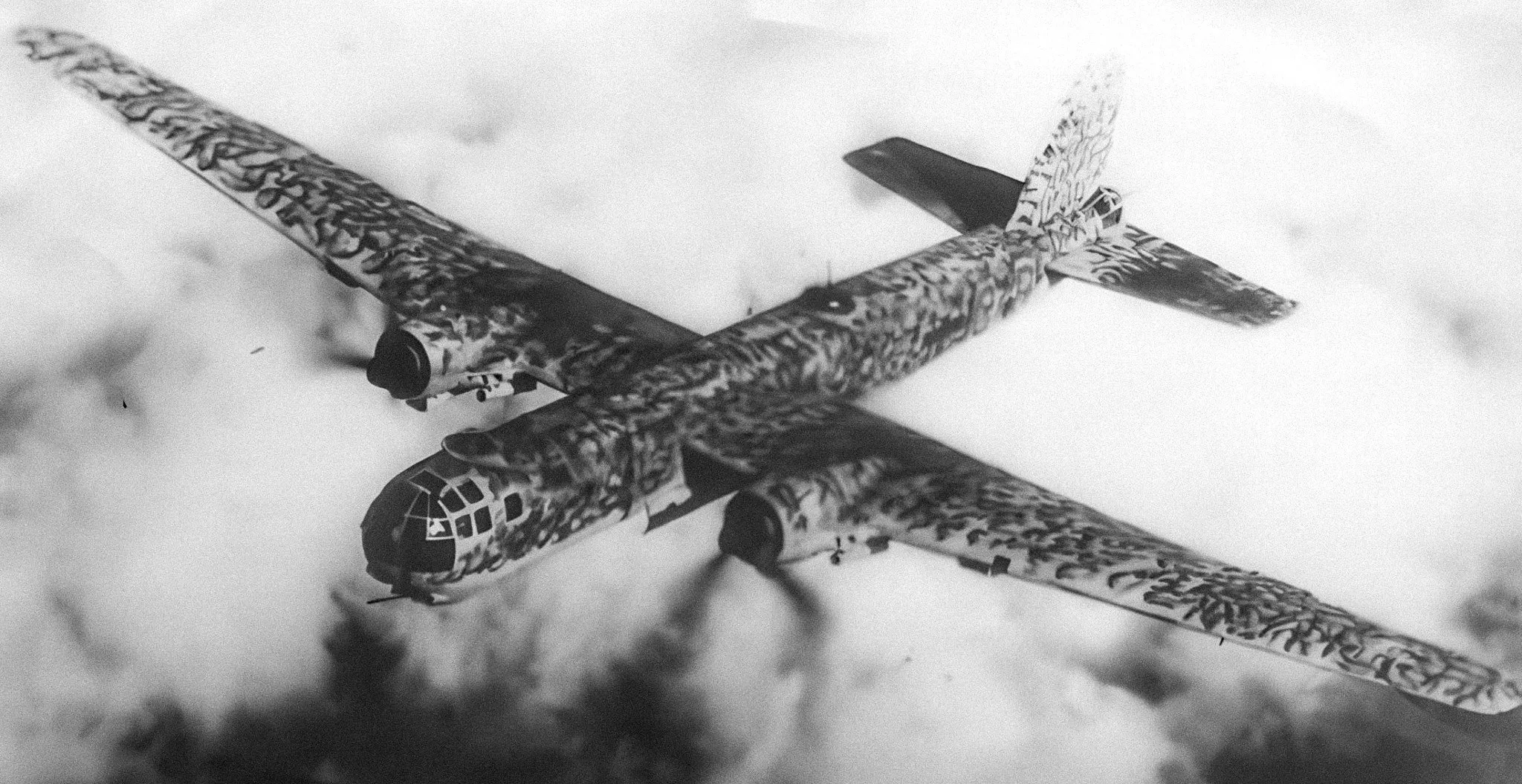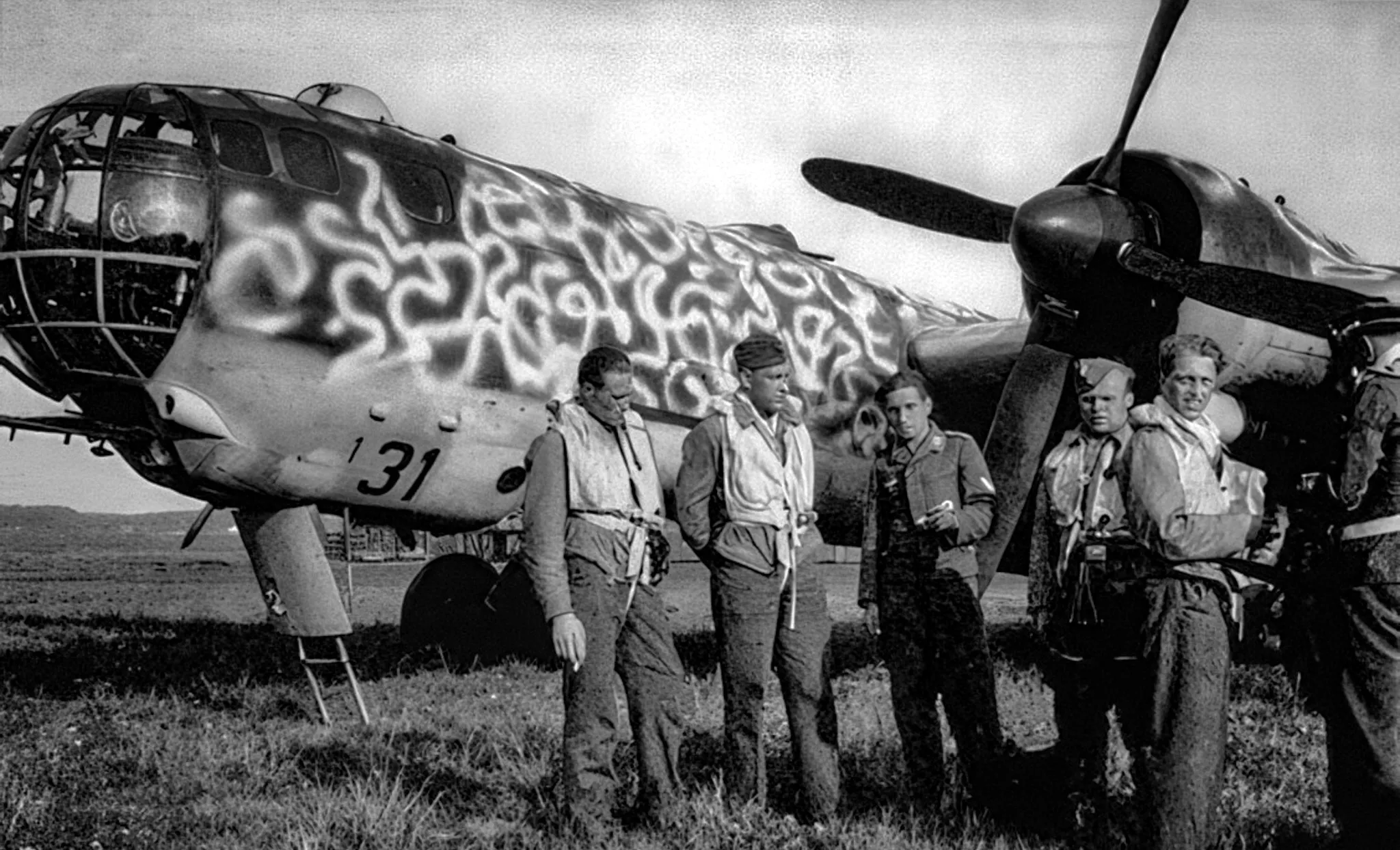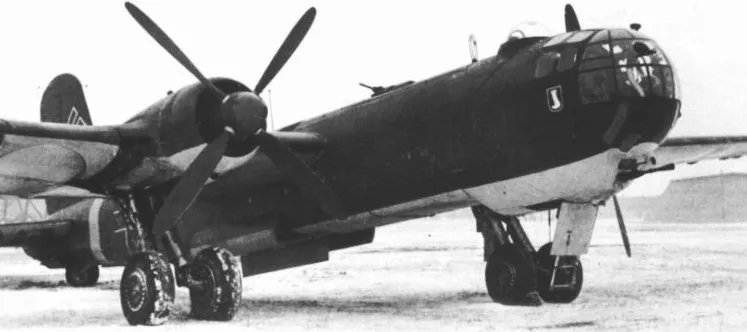Warplanes of Germany: Luftwaffe Heinkel He 177 Greif
Heinkel He 177 Greif

(Bundesarchiv, Bild 101I-676-7969A-24 / Lückel / CC-BY-SA 3.0)
Crew members gather around a Heinkel He 177 bomber at Tannenberg, East Prussia, before a mission. The bomber normally carried a crew of five. It was dubbed the ‘flaming coffin’ by its crews as overheating was the cause of many engine fires.
The Heinkel He 177 Greif (Griffin) was a long-range heavy bomber flown by the Luftwaffe during the Second World War. The introduction of the He 177 to combat operations was significantly delayed, by both problems with the development of its engines and frequent changes to its intended role. Nevertheless, it was the only long-range, heavy bomber to become operational with the Luftwaffe during the war. The He 177 had a payload/range capability similar to that of four-engined heavy bombers used by the Allies in the European theatre.
Work on the design began in response to a 1936 requirement known as Bomber A, issued by the RLM for a purely strategic bomber. Thus the He 177 was intended originally to be capable of a sustained bombing campaign against Soviet manufacturing capacity, deep inside Russia.In contrast to its heavy payload and very wide, 30 metres (98 ft) planform, the specifications called for the design to have only two very powerful engines. To deliver the power required, the He 177 needed engines of at least 2,000 horsepower (1,500 kW). Engines of this type were new and unproven at the time. The Daimler-Benz DB 606 power system that was selected, in conjunction with its relatively cramped nacelles, caused cooling and maintenance problems, such that the powerplants became infamous for catching fire in flight, and contributing to the He 177 gaining nicknames from Luftwaffe aircrew such as Reichsfeuerzeug ("Reich's lighter") or Luftwaffenfeuerzeug ("Air Force lighter").
The type matured into a usable design too late in the war to play an important role. It was built and used in some numbers, especially on the Eastern Front, where its range was particularly useful. It is notable for its use in mass raids on Velikiye Luki in 1944, one of the late-war heavy bombing efforts by the Luftwaffe. It saw considerably less use on the Western Front, although it played a role during Operation Steinbock (the "Baby Blitz"), against the UK in 1944. (Wikipedia)

(Luftwaffe Photo)
Heinkel He 177 A-5 Greif of the 6/KG 1 in flight, Summer 1944. The He 177 featured paired engines: two Daimler-Benz DB 606 engines, each combining two V-12 engines into a single powerplant. This gave the plane immense power, but it also made the engines prone to overheating, fires, and maintenance issues.

(Luftwaffe Photo)
Heinkel He 177 Greif, II./KG 100 out of Aalborg, Denmark in the Summer of 1944.

(Bundesarchiv, Bild 101I-674-7767-09 / Keiner / CC-BY-SA 3.0)
Heinkel He 177 during refueling and engine-run up 1943. Note the four-bladed propeller. The aircraft is painted in a night camouflage scheme.

(Luftwaffe Photo)
The Luftwaffe experimented with heavier gun armament for use against ground targets. Here is the He177 V12 fitted with a 30 mm MK 101 cannon. This weapon was tested but did not enter production. This Heinkel He 177 was coded GI+BL.

(Luftwaffe Photo)
Heinkel He 177 B 5, May 1944.

(Bundesarchiv, Bild 101I-676-7969A-23 / Schröder / CC-BY-SA)
Heinkel He 177A-5/R6 Greif (Griffon) long-range heavy bomber, September 1944.

(Luftwaffe Photo)
Heinkel He 177 in flight.

(Bundesarchiv, Bild 101I-668-7164-35A / Linden / CC-BY-SA 3.0)
Heinkel He 177 A-3/R2 of the 2./KG 100 being loaded with bombs.

(Bundesarchiv, Bild 101I-676-7972A-14 / Blaschka / CC-BY-SA 3.0)
Heinkel He 177 Greif (Wk.Nr. 550043), coded 6N+HM, undergoing engine maintenance on this 4./KG 100 machine. Note the second cylinder’s exposed exhaust stub being even with the leading edge, an indication of the rearwards location of the power systems. The aircraft was designed to have this special crane fitted when a block and tackle was needed to service the engines. Note the spinner on the hardstand in front of the aircraft and how uneven the spiral is painted.

(Luftwaffe Photo)
Heinkel He 177 Greif.

(Luftwaffe Photo)
Heinkel He 177.

(Bundesarchiv, Bild 101I-676-7972A-34 / Blaschka / CC-BY-SA 3.0)
Heinkel He 177A-5/R6 Greif (Griffon) tail gun position, with MG 151 cannon and bulged upper glazing for upright gunner’s seating.
.webp)
(IWM Photo, HU 2965)
Heinkel He 177 A-5 (W.Nr. 550054, KM+UD) of 6./KG 40 in France, in 1944.

(Luftwaffe Photo)
Heinkel He 177 (Wk Nr. 000017), the second prototype operated by Erprobungsstelle Rechlin.

(Luftwaffe Photo)
Heinkel He 177 in flight.

(Luftwaffe Photo)
Heinkel He 177 prototype 12 is an A-1/Us, coded GI+BL fitted with twin 30mm cannon. This adaptation was never installed on production aircraft.

(Luftwaffe Photo)
Heinkel He 177.

(Bundesarchiv, Bild 101I-676-7969A-25 / Schroeder / CC-BY-SA)
Heinkel He 177A-5/R6 Greif (Griffon) long-range heavy bomber.

(Bundesarchiv Bild 101I 674 7766 25A Keiner CC BY-SA 3.0)
Heinkel He 177 nose defences.

(Luftwaffe Photo)
Heinkel He 177 Greif.

(Luftwaffe Photo)
Heinkel He 177 A-5 of KG 100.

(Bundesarchiv Bild 101I 668 7163 24A Linden CC BY-SA 3.0)
Heinkel He 177, low level flypast.

(Bundesarchiv Bild 101i-674-7767-09)
An He 177A-3 of Flugzeugführerschule (B) 16 starting engines. The cart in front of the aircraft is an electrical generator which was widely used on Luftwaffe airfields while starting engines or to replenish batteries within the aircraft. The ground crewman on the left stands by with a fire extinguisher, a prudent precaution.


(USAAF Photos)
Heinkel He 177A-7 Grief, (Wk. Nr. 550256), coded GP+RY, captured at Toulouse-Blagnac, France in Sep 1944. It wore French markings including the title “Prise de Guerra”, until it was allocated to the USA. It had the star and bar insignia added and was marked 56 under the nose section. This aircraft crashed at Paris-Orly airport at the start of its intended ferry flight to the USA on 28 Feb 1945.

(USAAF Photo)
Heinkel He 177A-5 (s/n 550062, RAF serial TS439) being tested by the Royal Air Force in 1944-1945. The He 177 (coded F8+AP of II./KG 40) was captured by the French Resistance at the end of August 1944 at the maintenance factories of Toulouse-Blagnac. It was in flight condition. French national markingss were then applied to it, but it was to be delivered to the Allies, in this case to the RAE (Royal Aircraft Establishment) of Farnborough. In anticipation of this flight and to avoid any unfortunate and fatal confusion, reconnaissance bands inspired by the invasion bands of D-Day were painted on the plane and it was flown from Toulouse to Farnborough in a flight lasting 2 h 45 min on 10 September 1944.



Heinkel A-5 flown by the RAE for evaluation (Serial No. TS439).


(RAF Photos)
This He 177 Greif was captured by the French Resistance in Toulouse-Blagnac in August 1944. It was then to be handed over to the British for evaluations, but not before it was painted with distinctive bands, similar to the invasion stripes used for D-Day. This limited the chances of allied aircraft attacking the He 177.





